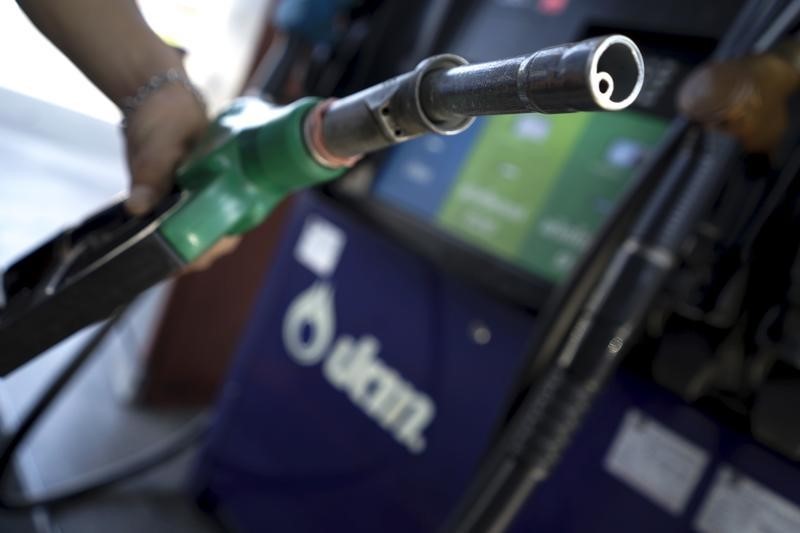Oil steadies as EIA calls Brent at just under $80
2023.06.06 16:23

© Reuters.
Investing.com — Crude markets plunged 2% Tuesday to defy the latest Saudi gambit on lower production, before steadying on a relatively positive forecast from the U.S. government that helped prices give back no more than what they gained a day ago.
New York-traded West Texas Intermediate, or , crude settled at $71.74 a barrel after erasing all of the 41 cents, or 0.6%, gained on Monday. During the most intense part of Tuesday’s slide, WTI fell to $70.14 — almost testing its key $70 support.
London-traded crude settled at $76.29. That was 42 cents, or 0.6%, down on the day versus the previous day’s gain of 58 cents, or 0.8%. Brent hit a session low of $74.73 on Tuesday.
Crude prices recovered from Tuesday’s lows after the latest supply-demand and market outlook published by the U.S. Energy Information Administration, or EIA, following a production cut announced by Saudi Arabia on Sunday.
Brent is expected to average at just below $80 per barrel in the second half of this year and under $85 in 2024, the EIA said.
WTI is expected to average $73.86 for the rest of 2023 and $78.50 for 2024, the EIA’s Short-Term Energy Outlook for June said.
“Everyone’s trying to get an idea of what the latest Saudi production maneuver will mean for crude prices going forth,” said John Kilduff, partner at New York energy hedge fund Again Capital. “The average everyone seems to be betting on is just under $80 or above that. So far, hardly anyone sees a barrel sustaining above $90.”
Saudi Arabia’s energy ministry said on Sunday the kingdom’s oil output will drop to 9 million barrels per day in July, as it accounted for an additional million barrels per day it will cut next month amid active summer travel and energy consumption in the Northern Hemisphere.
Since October, the Saudis have been producing 1.5M barrels below their regular average daily production of 11.5M. Their latest maneuver appeared aimed at keeping Brent from mid-$75 lows and WTI from revisiting the $60s.
Oil revenue is the lifeblood of the economies in OPEC, or the Organization of the Petroleum Exporting Countries, a 13-member Saudi-led group whose main objective is to be the price-setter of the commodity. Ten other oil producing states, including Russia, that aren’t OPEC members have also been keeping their output closely in line with the group’s for the sake of price. The 23-nation alliance is collectively known as OPEC+.
Over the past eight months, OPEC+, led by Saudi Arabia has announced two production cuts totaling 3.7M barrels per day, without much to show for in prices.
Analysts at Citigroup said achieving commensurate demand with supply appeared difficult for both this year and next in order to keep crude consistently at $80-$90 per barrel.
“Taking into account adjustments on both the supply and demand side seen in the full supply-demand balances…we see average quarterly prices fairly range-bound for the year, averaging $81 for Brent in both 1H and 2H but with the potential to range between $72 and $90,” Citi’s analysts said in a note.
Market participants were also on the lookout for U.S. weekly oil inventory data, due after market settlement from API, or the American Petroleum Institute.
The API will release at approximately 16:30 ET (20:30 GMT) a snapshot of closing balances on U.S. crude, gasoline and distillates for the week ended June 2. The numbers serve as a precursor to official inventory data on the same due from the U.S. Energy Information Administration on Wednesday.
For last week, analysts tracked by Investing.com expect the EIA to report a build of 1.152M barrels, versus the 4.488M barrel rise reported during the week to May 26.
On the front, the consensus is for a draw of 0.239M barrels over the 0.207M-barrel decline in the previous week. Automotive fuel gasoline is the No. 1 U.S. fuel product.
With , the expectation is for a drop of 0.110M barrels versus the prior week’s gain of 0.985M. Distillates are refined into , diesel for trucks, buses, trains and ships and fuel for jets.








